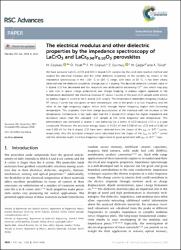| dc.contributor.author | Coşkun, Mustafa | |
| dc.contributor.author | Polat, Özgür | |
| dc.contributor.author | Coşkun, Fatih Mehmet | |
| dc.contributor.author | Durmus, Zehra | |
| dc.contributor.author | Çağlar, Müjdat | |
| dc.contributor.author | Turut, Abdülmecit | |
| dc.date.accessioned | 2019-10-20T09:03:00Z | |
| dc.date.available | 2019-10-20T09:03:00Z | |
| dc.date.issued | 2018 | |
| dc.identifier.issn | 2046-2069 | |
| dc.identifier.uri | https://dx.doi.org/10.1039/c7ra13261a | |
| dc.identifier.uri | https://hdl.handle.net/11421/16594 | |
| dc.description | WOS: 000423898000016 | en_US |
| dc.description.abstract | We have prepared LaCrO3 (LCO) and 10% Ir doped LCO samples by the solid state reaction method and studied the electrical modulus and the other dielectric properties of the samples by means of the impedance spectroscopy in the -100 degrees C to 100 degrees C range, with steps of 20 degrees C. It has been clearly observed that the dielectric properties change due to Ir doping. The absolute dielectric constant value of Ir doped LCO has decreased and this reduction was attributed to decreasing Cr6+ ions which may play a vital role in space charge polarization and charge hopping. A plateau region appeared in the temperature-dependent real electrical modulus M' versus f curves of the pure LCO sample while almost no plateau region is visible in the Ir doped LCO sample. The temperature-dependent imaginary modulus M" versus f curves has two peaks at each temperature; one of the peaks is at low frequency and the other at the high frequency region, which shifts through higher frequency region with increasing temperature. This originates from free charge accumulation at the interface with the increase of the temperature. Furthermore, it has been seen that the Ir doped LCO sample has higher impedance and resistance values than the undoped LCO sample at the same frequency and temperature. This phenomenon was attributed to doped Ir ions behaving like a donor in LCO because LCO is a p-type compound. Moreover, the activation energy values of 0.224 eV and 0.208 eV for LCO and of 0.161 eV and 0.265 eV for the Ir doped LCO have been obtained from the slopes of the rho(dc) vs. (kT)(-1) curves, respectively. Also the activation energies were calculated from the slopes of the f(ma)x vs. (kT)(-1) curves and the obtained results from low frequency region were in good agreement with rho(dc) vs. (kT)(-1) ones. | en_US |
| dc.description.sponsorship | Scientific and Technological Research Council of Turkey (TUBITAK) [116F025] | en_US |
| dc.description.sponsorship | This work was supported by The Scientific and Technological Research Council of Turkey (TUBITAK) through Grant No: 116F025. | en_US |
| dc.language.iso | eng | en_US |
| dc.publisher | Royal Soc Chemistry | en_US |
| dc.relation.isversionof | 10.1039/c7ra13261a | en_US |
| dc.rights | info:eu-repo/semantics/openAccess | en_US |
| dc.title | The electrical modulus and other dielectric properties by the impedance spectroscopy of LaCrO3 and LaCr0.90Ir0.10O3 perovskites | en_US |
| dc.type | article | en_US |
| dc.relation.journal | Rsc Advances | en_US |
| dc.contributor.department | Anadolu Üniversitesi, Fen Fakültesi, Fizik Bölümü | en_US |
| dc.identifier.volume | 8 | en_US |
| dc.identifier.issue | 9 | en_US |
| dc.identifier.startpage | 4634 | en_US |
| dc.identifier.endpage | 4648 | en_US |
| dc.relation.publicationcategory | Makale - Uluslararası Hakemli Dergi - Kurum Öğretim Elemanı | en_US |
| dc.contributor.institutionauthor | Çağlar, Müjdat | |


















